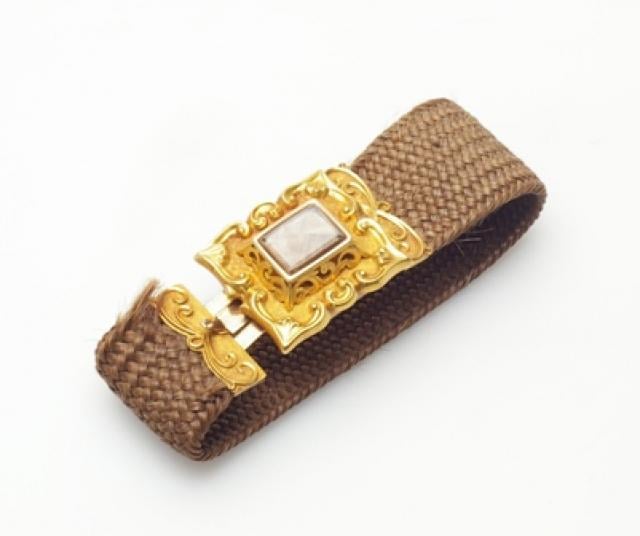Wedgwood and Jewellery: Mourning Hair Bracelet
This bracelet has a band of interwoven human hair mounted on a decorated gold clasp. The clasp features a setting with faceted crystal to protect two different sets of hair, its rear is engraved:
Josiah Wedgwood
died July 12th 1843
aged 74
Elizabeth Wedgwood
died March 31st 1846
aged 82
It relates to the deaths of Josiah Wedgwood II and his wife, Bessie (Elizabeth) Allen. The bracelet is probably made of Bessie’s hair and the two locks under the crystal are most likely hers and her husband’s. It was probably commissioned after their death by their eldest daughter, Sarah Elizabeth. Taking into account the good condition and the apparent traces of wear, it must have been a highly cherished sentimental piece of jewellery.
Hair incorporated in a piece of jewellery like a brooch, a locket or a ring was a traditional token of affection as it was a way to keep a part of a loved one close by. In the early years of the 19th century, plaited or woven hair jewellery became popular and, although they had no intrinsic value, items such as this were very fashionable.
Jewellery using human hair was made by professionals as well as by Victorian ladies who turned it into a drawing room pastime. In 1871, Mrs Alexanna Speight published 'The Lock of Hair – The Art of Working in Hair'. Mrs Speight was a professional London hairworker and her book comprised both the history of hairwork and a manual. Special equipment such as curling irons or tongs, scissors, knives, tweezers, brushes and weights were required, which could be purchased from professional hairworkers. For practising purposes, choosing horsehair was very helpful because it was easier to handle than human hair due to its coarseness. And even if you weren’t able to, or just didn’t want to do it yourself, you could simply send the hair to a professional hairworker and choose from a variety of designs.
Sentimental hair jewellery like this, with or without metal fastenings, was still made in the early 1900s.
